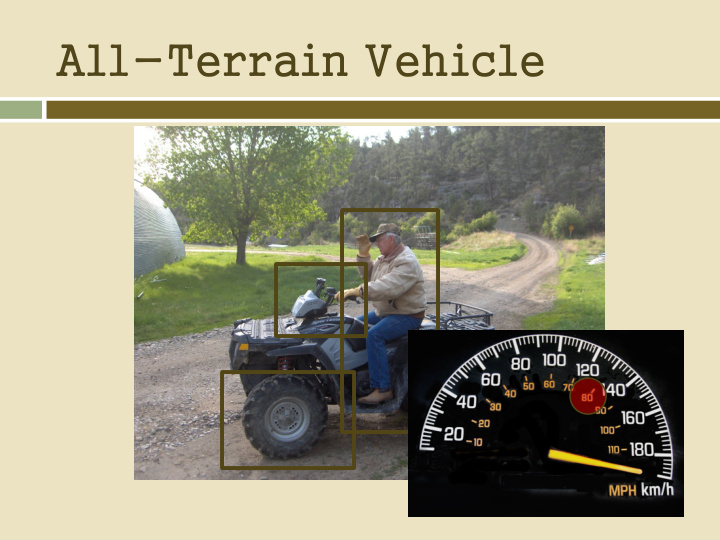



All-Terrain Vehicle
ATV adaptation by ranchers Herding livestock Mending Fences Weed Spraying
Common ATV Fatality/Injury Events
Injuries and Fatalities The steady increase in ATV use increase in preventable ATV injuries and deaths: An estimated 400,000 injuries and 800 deaths occur on ATV's each year in the U.S (GAO 2010).
Injuries and Fatalities 1992—2007 ATV deaths increased ~275% (From 11 deaths to 41 deaths) Fatality rate per 1 Million workers increased ~300% (0.07 in 1992 vs. 0.28 in 2007) *This rate is conservative
Injuries and Fatalities - Agriculture A disproportionate number of incidents at the agricultural: Comprise 65% of fatalities while representing only 20% of riders (Helmkamp, et al., 2009).
Injuries and Fatalities - Agriculture workers age 18+ in the agriculture production industry accounted for the largest number and had the highest rate of ATV-related deaths compared to any other industry sector
potential factors associated with accidents and injuries Factors including speed, pitch and roll are associated with loss of control events (Carman et al., 2010). ATV characteristics such as high center of gravity and short wheel base.
The Training Pre use check Operator preparedness components Maintenance issues Awareness about differences in ATV makes and models Identification of hazards in loading, unloading, trailer towing, winch operation, and securing of ATVs
The Training Bailout performance Personal protective equipment requirements Operation skills: safe turns, climbing and descending hills, navigating obstacles, water crossing, scanning and evaluation techniques
The Training Formal, Hands-on ATV Rider Training Provided by the ATV Safety Institute
General ATV Safety ATVs have operator age limitations— Observe Them Keep a well-maintained ATV - do a safety inspection each time it is used Fit the ATV to the task. A smaller machine is easier to move by hand if necessary Always lean your body uphill to prevent tipping and flipping. Stand up and really lean into the hill
General ATV Safety Be extra careful if you have a load (front or back) Before dismounting stop ATV completely (preferably on a level surface), set brake, and shift into park. Keep an eye out for new environmental hazards like rocks, logs, sinkholes, ice patches, etc.
ATV and Animal handling Approach at low speeds to avoid startling the animals. If animals are causing you frustration, don’t act on it, otherwise, you’ll overlook hazards. Use caution when making sharp turns at higher speeds. Animals can always cut sharper corners than a vehicle.
ATV and Animal handling Standing on the foot rests may make you appear larger and more imposing to the animals and invite less resistance. Don’t ride alone; Be aware of all riders’ whereabouts. If you’re moving animals, use ATVs alongside horses, dogs, trucks, etc. Communicate with others on ATVs or horses. Use hand signals, radios, etc.
Spraying with ATVs Don’t use an inferior spray system. Keep weight balanced -lowest practical center of gravity. (Sloshing liquid can significantly change ATV handling.) Use a spray tank that has internal baffles. This will reduce liquid surges and improve overall stability when turning on slopes or hills.
Spraying with ATVs Choose booms that can be operated as low to the ground as possible or use a nozzle sprayer. ATVs should only be fitted with rear-mounted spray booms or other equipment to reduce the risk of pesticide exposure.
Spraying with ATVs Don’t ride and spray when using a wand. If you’re using this setup, make sure the ATV isn’t moving while you’re spraying. Do not drag your spray hose to avoid losing control of the ATV.
Spraying with ATVs Only use the speed that you need—the optimal speed for good spray distribution is probably slower than you’d like. hi highe her s r speeds m s mean great ater r chan ances s of f miss issing y your t targ arget, and nd wor orse, p pos ossib ibly ly l los osing ing TV . . co control o of t the ATV
Fencing with ATVs Use a trailer to transport heavy loads of posts and tools instead of stacking too much weight onto the ATV. If you know you’re going to have to build or replace a lot of fence, take the pick-up truck or make multiple trips.
Fencing with ATVs Secure fencing tools and materials. Watch your speed—high speeds mean higher chances of losing control, especially if you’re carrying extra weight.
Personal Protective Equipment Use protective gear— A motorcycle helmet A pair of glasses, goggles or face shield All will help reduce the risk of injury as well as keep dust and debris out of your eyes.
Expected Outcomes increased awareness of ATV safety issues Alteration of behavior
Thank You
Recommend
More recommend